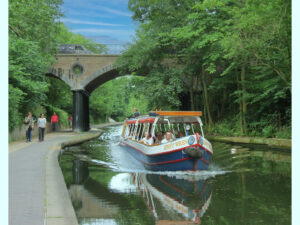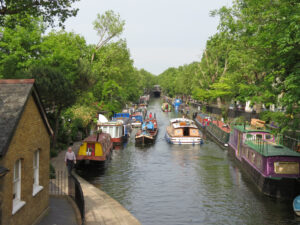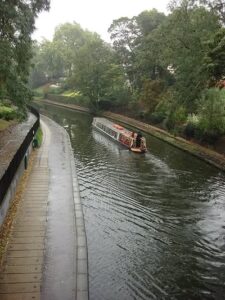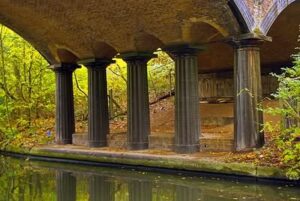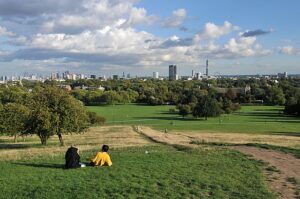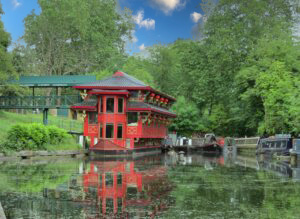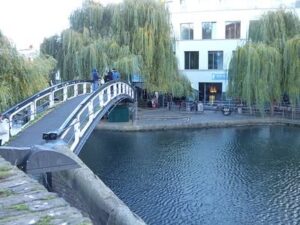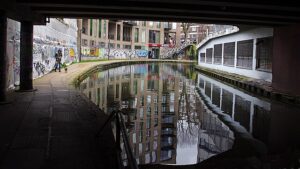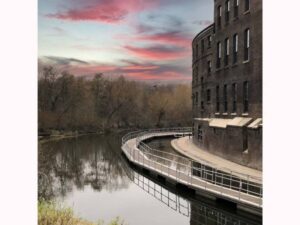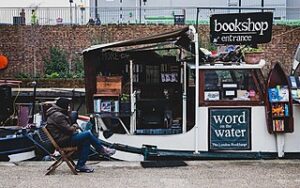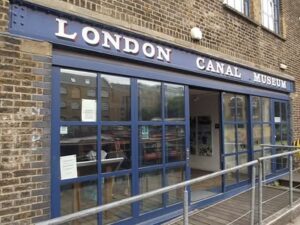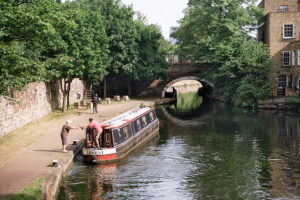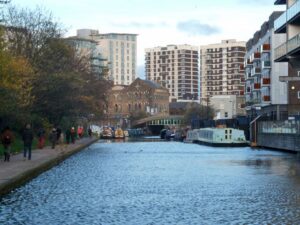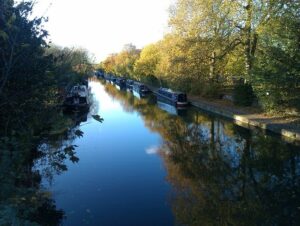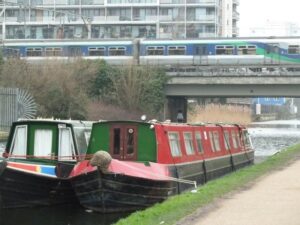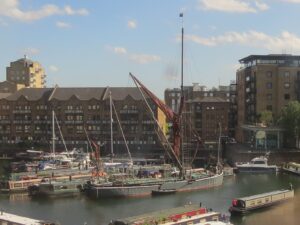16 Top Things to Do Along Regent’s Canal
Date post added: 21st August 2024
Flowing across London from Paddington Basin in the west to Limehouse Basin in the east, Regent’s Canal is a tranquil waterway in the heart of the city. On its journey to the River Thames it passes through London landmarks including Little Venice, Regent’s Park, London Zoo and Camden Market.
Wandering along the Regent’s Canal is a wonderful way to unwind from busy London life. Whilst swimming is prohibited in the canal, you’ll find many people canoeing, kayaking and paddleboarding. There’s so much to see along this interesting London waterway. Here, our canal guide, waterway aficionado and canoe enthusiast Roger reveals the top things to look out for along the Regent’s Canal path.
What and where is the Regent’s Canal?
Back in the 19th century, Britain’s waterways were important transport links. The initial idea for The Regent’s Canal was to connect Birmingham and the Midlands with the River Thames and the Grand Union Canal. It was architect and town planner, John Nash who suggested it should be used to transport goods from west to east London. That was in 1812, and eight years later the 14km long waterway was complete.
These days, it’s less about transport and more about leisure time. It’s also a place to call home for increasing numbers of houseboat dwellers, and a top spot to press pause and enjoy the view from a waterside cafe. Boat trips along the canal are also popular, be that by narrowboat, canal boat or London waterbus.
What are the top attractions to visit along Regent’s Canal?
Roger shares his fascinating insights and local gems to look out for as you walk along the canal towpath going east from Little Venice.
Little Venice
Little Venice is an attractive area where colourfully painted houseboats line the canal. This Little Venice section of the canal, from Warwick Avenue to Maida Vale, is perhaps more like Amsterdam than Venice. Look out for it in A Fish Called Wanda – ten minutes after the start.
It was Byron who made the first reference to Venice, ‘… there would be nothing to make the canal of Venice more poetical than that of Paddington, were it not for its artificial adjuncts.’
Browning’s Pool is a focal point on the waterways. The passenger boats coming and going at Browning’s Pool are a real part of the story. Most of them were built to carry cargo in the commercial era of the canals, and were later modified to take passengers.
Regent’s Park
When the canal passes by Regent’s Park, the towpath is an absolute delight. The mostly tree lined cutting feels like a different world!
We have the famous classical revival architect, John Nash to thank for the park as well as the canal. In 1811 he transformed Henry VIII’s former hunting ground into Regent’s Park with landscaped gardens, lakes, playing fields and rose gardens. He also designed Hanover Lodge, the first house on the right.
In the summer months, the open air theatre in Regent’s Park is a delightful way to spend an evening. And year round, London Zoo is a great destination. Look out for the aviary from the towpath.
Charlbert Street footbridge
This is the first bridge over the canal in the park. We say bridge, but this rather solid construction is actually an aqueduct. It was built containing a large iron pipe to carry one of London’s ’lost’ rivers, the River Tyburn, on its way from Hampstead to the River Thames.
Macclesfield Bridge
The three brick arches of Macclesfield Bridge are on the northern edge of Regent’s Park. It’s better known as ‘Blow Up Bridge’ after an explosion of a barge cargo of gunpowder totally destroyed the bridge in 1874. When the contractors rebuilt the bridge, they installed the support pillars the other way round, so there are rope-wear grooves on the pillar sides facing away from the water. At the top of each pillar, you’ll see the name Coalbrookdale – which was the starting place of the Industrial Revolution, which led to the need for the canal network.
Primrose Hill
The popular London village, Primrose Hill, is well worth a little detour from the canal. There are chic boutiques, great gastropubs and so many brunch spots. But it’s the climb to the top of the hill that is an absolute must for super views of the London skyline.
Floating Chinese restaurant
At the Cumberland Turn, look out for a large, colourful Chinese barge. The Feng Shang Princess is a floating Chinese restaurant. It’s a good one too. Tuck into your Peking duck or chow mein from this waterside location.
The converted barge is much larger than any other boat on the canal. In the 1980s, it was floated here in sections and assembled in situ.
Horse ramp
After Cumberland Turn, a cut-out in the towpath is actually a horse ramp. If a horse lost its footing, and fell in the canal, it could take some time to get it back on the towpath. This would create a traffic jam of other barges waiting to pass. A horse ramp is a stone-lined slope up to towpath level which the horse could climb up this ramp and reconnect to its barge. Typically, barge drivers often found other uses for the horse ramps. So the canal company brought in a rule that anyone found washing their horse on a ramp would be hit with a stiff fine.
Camden Lock
Just before Camden Lock, there’s a waterway tunnel known as ‘Dead Dog Cut.’ It’s on the left underneath the Interchange Building and was used as a location in the 2015 James Bond film Spectre, as Q’s top-secret underground workshop.
The Grade II listed footbridge over Dead Dog Cut is used by a million people a year. It’s just been restored to its original 1846 condition, and its original Indian Red paint colour.
The diagonal bridge across the canal just before Camden Lock dates back to 1846. Take in the lovely view in both directions along the canal. It’s a place to take a breath and pause before you tackle the delights of Camden Town and the internationally famous Camden Market.
Kings Cross
The Granary Building in Granary Square, King’s Cross is now known as the campus of Central St Martin’s, part of the University of the Arts, London. They hold catwalk fashion parades there.
Granary Square, and the building itself, keep this name because it was built as a granary and transhipment building in 1852. Grain was transported from Lincolnshire in railway wagons and transferred into waiting canal barges for onward transport to customers across north London. The tunnels for the barges, under the Granary, were filled in just after WWI, and would now effectively be part of the foundations. The steel circles in the floor mark the locations of the wagon turntables, where wagons were manoeuvred to unloading positions. The locations of the trapdoors in the ceiling, for hoists to lift sacks of grain to higher floors, can still be seen in the patterns of the ceiling joists.
Word on the Water
Beside Granary Square near King’s Cross Station, don’t miss London’s only floating bookshop. Word on the Water is a restored 1920s Dutch barge, packed with affordable books. Look out for live music and poetry events which are held on its roof.
London Canal Museum
Discover the history of London’s waterways at London Canal Museum. You can venture inside a narrowboat and learn about the people who lived and worked on the canals. They also run a very popular trip boat along the canal from here.
The building itself was originally Carlo Gatti’s Ice Warehouse. His pioneering role in promoting ice cream in London is celebrated by ice cream making sessions at the museum.
Islington
Islington Tunnel is 880 metres (960 yards) long and passes 18 metres (60 ft) under Islington Upper Street. Drivers fuming in queues at the traffic lights above have no idea that boaters are cruising underneath them without a care in the world!
City Road Lock and Basin in Islington is a pleasant place to sit and relax and watch the swans and ducks and other waterbirds. There’s a nice cafe here, housed in what was once the stables for the Canal Company’s horses. It’s hard to imagine now that this relatively peaceful location was once a major hub of traffic on the canal.
The Narrow Boat pub, just after Wharf Road, is the only Islington pub that’s right on the canal. From your table, you can look out over Wenlock Basin and the canal residents’ winter moorings.
Opposite the towpath, there’s an old white building with a distinctive Victorian design. This is Holborn Studios, the biggest photographic studios in Europe. Described by a leading photographer as “The Abbey Road of photography”, it has provided facilities for David Bailey and Annie Leibovitz. Madonna, Kate Moss, Kylie Minogue and many others have had their pictures taken here. Back in the 1840s, it was the Regent’s Canal Ironworks, Hoxton, which supplied ironwork for the Houses of Parliament, the British Museum and Buckingham Palace.
Hoxton to Hackney
There are several spots along this stretch of the canal which highlight its industrial heritage. In Hackney, there’s Kingsland Basin which houses Quebec Wharf. It was built in 1878, when trams were horse-drawn, to store fodder for the North Metropolitan Tramway Co. It’s the best remaining example of a canal-side granary in south east England. The exterior may reflect its industrial heritage, but these days the inside is converted into swanky flats.
Then there’s Hertford Wharf. Built at the end of 19th century, it was a multi-storey stables for the horses which hauled the dust-carts in Shoreditch.
Today’s residents on the basin’s moorings are enthusiastic about growing plants – even the warning sign says ‘Trespassers will be composted’!
Victoria Park
With over 200 acres of green space, Victoria Park (named after Queen Victoria) was London’s first public park. It’s home to summer festivals like Field Day and Lovebox. It’s a wonderful open air destination in East London for a picnic or to enjoy a cuppa and a pastry at the Pavilion Cafe.
A few unusual sights to look out for include a deer enclosure and fragments of the old London Bridge. Near the Bonner Hall canal bridge, the main entrance to the park is ‘guarded’ by replicas of two ancient Greek statues of ‘The Dogs of Alcibiades’.
Mile End
Between Queen Mary University of London and Mile End Park, keep your eyes open for the 19th century Lock Keeper’s cottage just beside the gate. The heavy-duty lock mechanism next to it serves as another reminder of the canal’s industrial origins.
Also in Mile End, the Ragged School Museum is worth a visit. It provides an interesting insight into the Victorian classroom – the permanent exhibition shows elements like dunces’ hats, inkwells and slate boards. The building was originally Victorian canalside warehouses, but in 1876 Dr Barnado turned it into a free school for poor, young children.
Limehouse Basin
The final stretch of the canal, Limehouse Basin was built in 1820 as the Regent’s Canal Dock. It’s where the canal merges into the River Thames. You can sometimes see Thames Sailing Barges here. The swing bridge on Narrow Street operates when a sailing boat is going to or from the Thames. The hydraulic accumulator tower of 1868 – once part of the power system to operate capstans, cranes and lock gates – provides a great vantage point for spectacular waterside views.
Explore the Regent’s Canal with elite, knowledgeable guides
It all comes down to the guiding. Local knowledge, expertise – it’s the secret sauce.
London Walks canal guides know their stuff. They’re all members of the Inland Waterways Association. There are several hundred miles of canals and rivers in and around London. That network takes some getting to know. The canal guides are like ship’s captains – they know what’s there, they know what they’re doing, they know where to go. They’ve earned their stripes from many years’ experience exploring those inland waterways. Exploring them not just on the towpath but by narrowboat (and, in Roger’s case, canoe). And indeed working in the Canal Museum. You go on a canal walk with ‘the Skipper’ you’re in the best possible hands. So Welcome Aboard. You’re going to see things you’d never see otherwise, you’re going to hear no end of great yarns, you’re going to tap into some very impressive expertise. But be warned: what the Canal Guides have been ‘smoking’ for many years – their deep and abiding passion for London’s Inland Waterways – is infectious. Towpaths, waterways, secret places, a London frozen in time – it doesn’t get any better than this.
Take a fabulous canal walk in London with our expert guides to the waterways.

